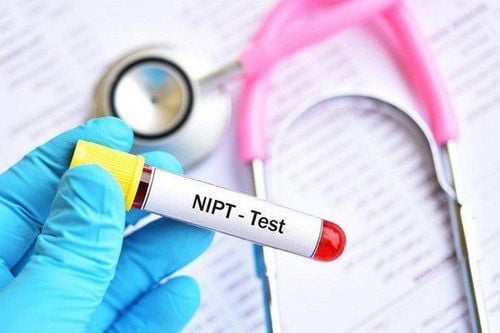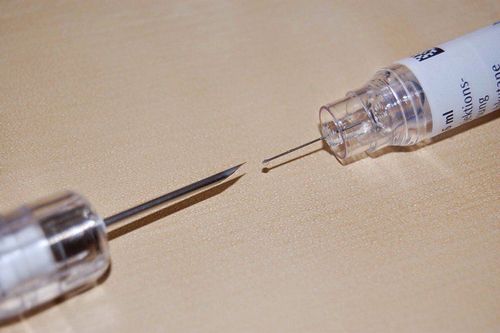This is an automatically translated article.
Most prostate cancers are detected by the results of a prostate-specific antigen (PSA) blood test or a digital rectal exam (DRE). In the early stages of prostate cancer, there are often no specific symptoms, but when the disease has reached a dangerous stage, the symptoms will become apparent. So what measures are accurate in diagnosing prostate cancer?1.Stages of Prostate Cancer If you are diagnosed with prostate cancer, your doctor may do additional tests and imaging techniques to determine the stage of the disease and whether whether the cancer has spread to other parts of the body. Knowing the stage of the disease will help the medical team to plan the best treatment for the patient.
Prostate cancer is staged using the following key information:
The size and extent of the tumor Whether the cancer has spread to nearby lymph nodes Whether the cancer has spread to other organs or tissues in the body that do not have a PSA level when diagnosing the Gleason Score from the results of a prostate biopsy. The stages of prostate cancer are:
Stage I: the tumor has not spread outside the prostate gland. The tumor is small and may or may not be palpable on digital rectal examination or seen with imaging techniques. If the tumor can be seen through the tests, then the tumor occupies half or less of the prostate gland and is located only on one side. Gleason score of 6 or less and PSA level less than 10. Stage IIA: The tumor has not spread beyond the prostate gland. The Gleason score can be 6 or lower but the PSA level is between 10 and 20, or the Gleason score can be 7 and the PSA level is less than 20. The tumor can occupy more than half of the prostate. Stage IIB: The tumor has not spread beyond the prostate gland. The tumor is small and may not be palpable on digital rectal examination or seen with imaging techniques, a Gleason score of 8 or higher, or a PSA level of 20 or higher. If the tumor can be seen with imaging techniques and is located on both sides of the prostate gland. Stage III: The tumor has spread to the outer layer of the prostate gland and may have spread to the seminal vesicles, but not to nearby lymph nodes. PSA levels and Gleason scores can be any level. Stage IV: Cancer has spread to nearby tissues such as the seminal vesicles, rectum, or bladder, to nearby lymph nodes, or to distant parts of the body such as bones. PSA levels and Gleason scores can be any level.

Hình ảnh mô tả các giai đoạn của ung thư tuyến tiền liệt
Tests to determine the stage of prostate cancer may include:
Rectal ultrasound Biopsy or removal of lymph nodes, tissue from the lymph nodes is taken for examination under a microscope en CT, MRI or other imaging techniques. 2. Measures to diagnose prostate cancer 2.1. Take your medical history and do a physical exam If your doctor suspects you may have prostate cancer, he or she will ask you about any symptoms you're experiencing, such as any problems with your prostate. urinary or sexual tract and how long these symptoms last. In addition, the patient may also be asked about possible risk factors, including family history.
The doctor will also examine the patient like a digital rectal exam (DRE) by, the doctor will put on gloves, lubricate his hands and insert a finger into the patient's rectum to feel any lumps. Any swelling or hard areas on the prostate gland are suspected to be cancerous. If a person has cancer, a DRE can sometimes help doctors see if the cancer is on one side or both sides of the prostate, or has spread beyond the prostate to nearby tissues. Your doctor may also check other areas of your body.
2.2. PSA blood test in men who may have prostate cancer Prostate-specific antigen (PSA) is a protein made by cells in the prostate gland (both normal and cancer cells). letters). PSA is mainly present in semen, but small amounts are also present in the blood.
The PSA blood test is used primarily to screen for prostate cancer in asymptomatic men. It was also one of the first tests to be performed on men with symptoms suspected of being caused by prostate cancer.
PSA in the blood is measured in units called nanograms per milliliter (ng/mL). The likelihood of prostate cancer increases as PSA levels rise, but there is no cut-off point that can tell for sure if a man has or doesn't have prostate cancer. Many doctors use a PSA cut-off of 4 ng/mL or higher when deciding whether a man may need another test or imaging technique, while others may recommend starting a test. lower levels, such as 2.5 or 3.
Most men without prostate cancer have PSA levels below 4 ng/mL of blood. However, a level below 4 does not guarantee that the man is cancer-free.

Xét nghiệm máu PSA ở nam giới giúp tầm soát ung thư tuyến tiền liệt
Men with PSA levels between 4 and 10 (often referred to as the “limited range”) have about a one-quarter chance of developing prostate cancer. If the PSA is above 10, the chance of prostate cancer is more than 50%. If your PSA level is high, you may need additional tests and imaging techniques to look for prostate cancer.
2.3. PSA blood test in men who have been diagnosed with prostate cancer The PSA test can also be helpful if a man has been diagnosed with prostate cancer.
In men who have just been diagnosed with prostate cancer, PSA levels may be combined with the results of a physical exam and the extent of the tumor (determined on a biopsy) to help decide if it is necessary. whether additional diagnostic techniques (such as CT or bone scan) are performed.
PSA levels are used to help determine the stage of a person's cancer. This result can affect treatment options, as some treatments (such as surgery and radiation) may not be helpful if the cancer has spread to other parts of the body. .
PSA tests are often an important part of determining the effectiveness of treatment and monitoring the likelihood of cancer coming back after treatment.
2.4. Prostate Biopsy If PSA, DRE, or other blood tests suggest prostate cancer, the next step is to perform a prostate biopsy.
Biopsy is a technique in which small samples of the prostate are removed and then examined under a microscope. Core needle biopsy is the primary method used to diagnose prostate cancer.
During a biopsy, the doctor usually looks at the prostate using imaging techniques such as transrectal ultrasound (TRUS) or MRI, or a combination of both. The doctor quickly inserts a thin, hollow needle into the prostate gland. This thin needle will pass through the wall of the rectum (transrectal biopsy) or through the skin between the scrotum and anus (transrectal biopsy). When the needle is withdrawn, it removes a small cylinder of prostate tissue. This technique is often repeated many times. Typically, the doctor will take about 12 such core samples from different parts of the prostate.
Although the procedure may sound painful, each biopsy usually causes only some brief discomfort, as the procedure is performed using a special spring-loaded biopsy instrument. This device inserts and withdraws the needle in just a fraction of a second. Most doctors who do biopsies will numb the area first by injecting a local anesthetic along the prostate.
This biopsy usually takes about 10 minutes. You will probably be given antibiotics before the biopsy and may take an extra day or two afterward to reduce the risk of infection.
For a few days after the procedure, the patient may feel some soreness at the biopsy area and may see blood in the urine. You may also experience light bleeding from the rectum, especially if you have hemorrhoids. Many men have blood in their semen or have rust-colored semen, which can last several weeks after the biopsy, depending on how often the man ejaculates.
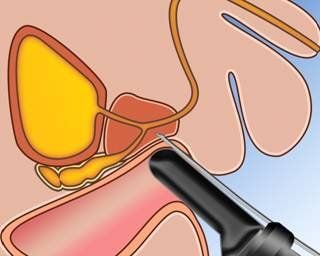
Phương pháp sinh thiết tuyến tiền liệt được áp dụng trong chẩn đoán chính xác ung thư tuyến tiền liệt
The patient's biopsy samples will be sent to a laboratory, where they will be examined under a microscope to see if they contain cancer cells. Results are usually available in as little as 1 to 3 days, but can sometimes take longer. Possible results include:
Cancer positive: Cancer cells were found in the biopsy sample. Cancer negative: No cancer cells were found in the biopsy samples. Suspicion: although some abnormalities are seen, it may not be cancer. 2.5. If the biopsy is negative If the prostate biopsy is negative and your chances of prostate cancer are not high based on your PSA level and other tests, you may not need further tests. except for subsequent repeat PSA (and possibly DRE) tests.
But even with multiple prostate samples, a biopsy can sometimes miss cancer if the needle doesn't remove cancer cells from the prostate. This is called a false negative result. If your doctor still suspects that you have prostate cancer (for example, when your PSA level is very high), your doctor may order more:
Other tests (blood, urine or birth samples) prostate) to help doctors better know if you may have prostate cancer. Examples of tests include the prostate health index (Prostate Health Index), the 4Kscore test, the PCA3 test (such as Progensa), and the ConfirmMDx. Repeat prostate biopsy. This time, your doctor may take additional samples of parts of the prostate that weren't biopsied the first time around, or use imaging techniques such as MRI to look more closely at abnormal areas that need specializing. special attention. 2.6. Genetic testing for some men with prostate cancer Some doctors now recommend that some men with prostate cancer have this test to look for inherited gene changes. Genetic testing should be performed in men with suspected familial cancer syndromes (such as BRCA gene mutations or Lynch syndrome), as well as in men with certain prostate cancers. high-risk score or has metastasized to other parts of the body.
2.7. Transrectal Ultrasound (TRUS) For this diagnostic technique, a small, finger-width probe is lubricated and placed into the patient's rectum. The transducer emits sound waves that enter the prostate gland and create an echo. The transducer picks up the echoes and a computer turns these sounds into a black and white image of the prostate gland.
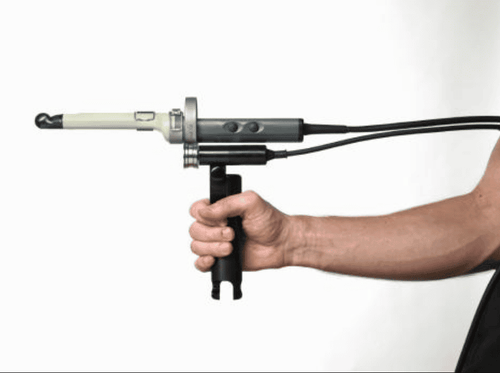
Hình ảnh đầu dò được sử dụng trong kỹ thuật siêu âm qua trực tràng
This process usually takes less than 10 minutes. The person will feel some pressure when the transducer is inserted, but it is usually painless. The area may be numbed before the procedure.
TRUS can be used in different situations:
Sometimes used to look for suspicious areas in the prostate in men with abnormal DRE or PSA test results.. May be used during a prostate biopsy to guide the needle into the correct area of the prostate. Can be used to measure the size of the prostate gland, which can help determine PSA density. Can be used to guide some forms of treatment such as brachytherapy (internal radiation) or cryotherapy. Newer forms of TRUS, such as color Doppler ultrasound, may even be more helpful in some cases.
2.8. Magnetic resonance imaging (MRI) An MRI scan creates detailed images of soft tissues in the body using radio waves and strong magnets. An MRI scan can give the doctor a very clear picture of the prostate gland and surrounding areas. A contrast material called gadolinium may be injected into a vein before the scan to see details better.
MRI can be used in different situations:
Can be used to help determine if men with abnormal screening tests or with symptoms suspected of prostate cancer should prostate biopsy or not. If a prostate biopsy is planned, an MRI may be done to help locate and target the areas of the prostate that are most likely to contain cancer. An MRI may be used during a prostate biopsy to help guide the needle into the prostate. If prostate cancer has been detected, an MRI may be done to help determine the extent (stage) of the cancer. An MRI scan can show whether cancer has spread beyond the prostate into the seminal vesicles or other nearby structures. This can be very important in determining a person's treatment options. 2.9. Bone scan If prostate cancer has spread to distant parts of the body, the cancer usually goes to the bones first. A bone scan can help determine if cancer has reached the bones.
For this technique, the patient is injected with a small amount of low-level radioactive material, which is deposited in damaged areas of bone throughout the body. A special camera detects the radiation and creates an image of the patient's skeleton.
A bone CT scan can suggest cancer in the bone, but for an accurate diagnosis, other diagnostic techniques such as a simple X-ray, CT or MRI scan, or even a bone biopsy may be needed.
2.10. Computed tomography (CT) CT scans use X-rays to create detailed, cross-sectional images of your body. This test is not usually needed for newly diagnosed prostate cancer if the cancer is likely to be localized to the prostate based on other findings (DRE results, PSA levels, and Gleason scores). However, it can sometimes help to tell if prostate cancer has spread to nearby lymph nodes. If your prostate cancer has recurred after treatment, a CT scan can often show whether it has grown to other organs or structures in your pelvis.
CT scans are not as useful as magnetic resonance imaging (MRI) for viewing the prostate.
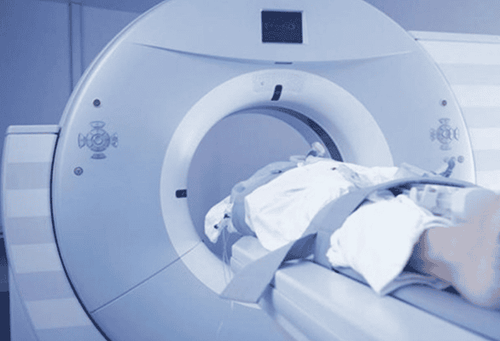
Chụp cắt lớp vi tính (CT) giúp phát hiện ung thư tuyến tiền liệt di căn
2.11. Lymph node biopsy In a lymph node biopsy, also called a lymph node dissection or lymphadenectomy, one or more lymph nodes are removed to see if they have cancer cells. This isn't done often for prostate cancer, but it can be used to find out if the cancer has spread from the prostate to nearby lymph nodes.
Early cancer screening is considered a perfect measure in the timely detection and treatment of all types of cancer. Reduce the cost of treatment and especially reduce the mortality rate in patients. Vinmec International General Hospital always deploys and introduces to customers HIGH-TECH CANCER CHECKLIST AND SCREENING PACKAGE for gene testing, imaging, and biomarkers for early tumor detection. Vinmec International General Hospital has many early cancer screening packages. Only one gene test can assess the risk of 16 common cancers in both men and women (lung cancer, colon cancer) rectal cancer , breast cancer , pancreatic cancer , cervical cancer , stomach cancer , prostate cancer ,....)
Early detection of early signs of cancer through diagnosis imaging, endoscopy and ultrasound. The operation is simple, careful and accurate. A team of well-trained specialists, especially in oncology, are capable of handling cancer cases. With facilities, advanced and modern medical equipment and a team of doctors with deep expertise and experience. At Vinmec, the examination process becomes quick with accurate results, saving costs and time for patients.
Please dial HOTLINE for more information or register for an appointment HERE. Download MyVinmec app to make appointments faster and to manage your bookings easily.
Reference sources: canceraustralia.gov.au, cancer.org
MORE:
Biopsies for rapid diagnosis of prostate cancer Robotic surgery to "blow up" prostate cancer for Japanese doctors Intensive examination package prostate cancer






